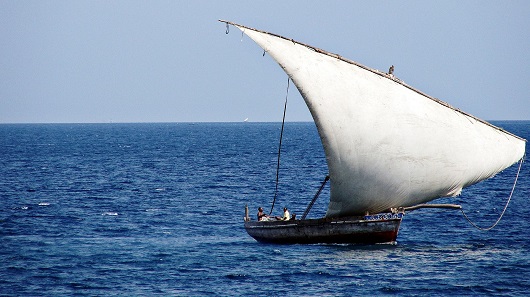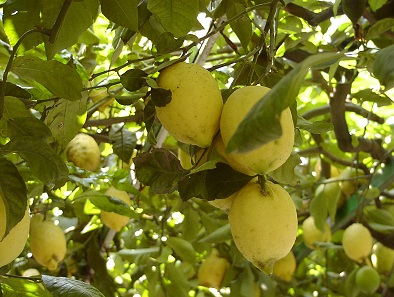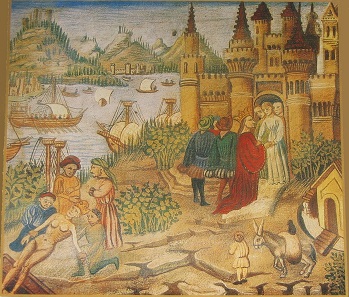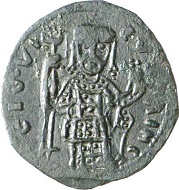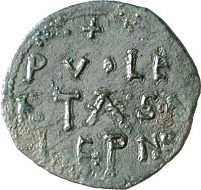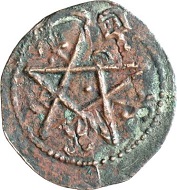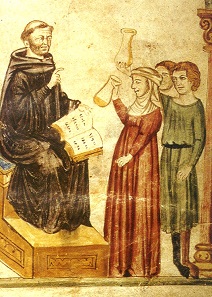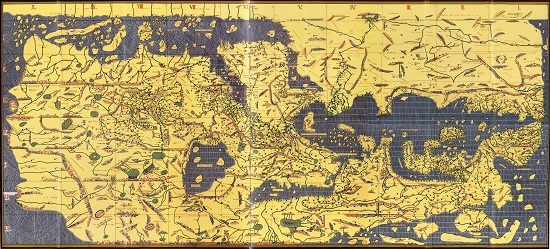translated by Annika Backe
In 827, the ruler of Tunis sent an army to subject Sicily. Although individual Byzantine enclaves successfully survived right into the 10th century, around AD 900 the island was an integral part of the Islamic world. And as such, it was integrated into the trading system of the Orient and participated in the then latest developments.
In the Arab world, today’s sailboats still look similar to the medieval ones. Back then, their technically advanced rigging created a milestone in Europe. Photo: SajjadF / CC BY-SA 3.0
Arab influence
Arab captains soon began to land in many ports of Southern Italy, such as Palermo or Amalfi, to trade. That was where European sailors saw their technically superior ships for the first time. For instance, the ships were equipped with sails that made it possible not only to sail close to the wind but to tack as well. Called ‘lateen sail’, this rigging was then adopted for the Christian ships. The compass, on the other hand, seems to have been invented by the Arabs and the Europeans together.
The impact of Islamic shipping on the Western one can be deduced from the large number of terms that were borrowed from the Arabic language. Admiral, cable, sloop, bark, and monsoon derive from Arabic, and in other languages, such as Spanish and Italian, an even greater influence becomes apparent.
Lemons. Orchard in Syracuse. Photo: KW.
Aside from the trade, the Arabs promoted tillage farming through new irrigation techniques. They introduced a whole new series of plants that are taken for granted today, such as sugar cane, cotton, lemons, oranges, eggplants, artichokes, apricots, and rice. Also the mulberry tree and silk worm breeding made their way to Sicily in the 10th century.
Wandering poets and musicians brought the refined taste of the Arab world to the courts of the small Sicilian emirs. From the tales of the well-traveled guests the noblemen and their servants learned how to dress, to behave, to furnish, what to do in the leisure time, or how to make a fine invitation. Certainly one heard it in Sicily, too, that a Baghdad-based musician had developed a binding sequence for every festive invitation in Southern Spain. By the way, formal dinners continue to adhere to this sequence.
With the Arabs their books arrived in Sicily. These books were no longer made of expensive and unwieldy parchment or papyrus, but of cheap paper. The Arabs had got to know this material in China and distributed it throughout the Arab world. Also in Sicily, paper became a matter of course. We know that in the 12th century Roger II of the Normans knew and used paper whereas in Germany and Italy the first paper mills were established as late as the 14th century.
The Arab books brought Arab science to Sicily and Lower Italy. It’s not necessary to mention that our current numerals hark back to the Arabs, and the foundations of modern mathematics were imported from the East.
The Salerno School of Medicine. Miniature from a book by Avicenna.
Salerno as a center of medicine in the West
The West became acquainted with many Greek writers through Arabic translations, especially the medical treatises written by Galen and Hippocrates. The basis for Salerno to become the most important center of medicine in the West was the close contact it had with the Islamic neighbors, even if Salerno was controlled by the Lombards.
Lombards. Gisulf I of Salerno (946-977). Follaro. From Künker sale 137 (2008), 3778.
As early as the 7th century, Salerno had a hospice of the Benedictines. This was a lodging where the needy were accommodated. People who were poor, old, in distress, or strangers could expect to get help, a meal and accommodation. Travellers who had become ill, received care in the hospice, until they were able to continue their journey. The monks took a natural interest in medicine. And they probably were very grateful when in the 10th century they found a Jew who had lived in Saracen captivity for quite a long time. He was able to compile some medical treatises that heavily relied on Arabic writings.
Lombards. Gisulf I of Salerno (946-977). Follaro. From Künker sale 137 (2008), 3779.
Through this the monks got access to a sophisticated healthcare system. It hadn’t been developed by the Arabs, though. Rather, when conquering Iraq, they had adopted and perfected it. In Baghdad there were hospitals, with affiliated medical centers for physicians. There were lecture halls, libraries, pharmacies, and, of course, doctors specializing in certain diseases. Between 800 and 1300, the medical writings of more than 70 authors were published in Arabic. And Salerno started with their translation.
Constantinus Africanus examining urine. Medieval miniature.
A man named Constantinus Africanus is said to have delivered a breakthrough for Salerno in the 11th century. There is little we know about him. Perhaps he began by earning his livelihood as a trader of medicinal plants. In Salerno, he allegedly noticed how poorly equipped even those were who tried to teach their pupils the relevant knowledge of basic medicine. This prompted him to study medicine in the East and to collect medical treatises. He returned to Italy and, as lay brother of the Monastery of Monte Cassino, he translated everything he had brought with him from the East. It was through his Latin versions that the knowledge of the findings of Hippocrates and Galen spread throughout the West, starting in Salerno.
Tabula Rogeriana by Al Idrisi, 1154. Bibliothèque nationale de France.
Arab knowledge under the Normans
Even after the Norman conquest, the new masters still possessed this knowledge. They outright promoted the Arab sciences and Muslim scientists. For instance, the West owed the decisive leap of understanding in the field of geography to Norman King Roger II, and above all to the scholar Al-Idrisi, whom he funded. On behalf of the King, Al-Idrisi compiled a description of the Earth along with a variety of maps. In the process, he asked travelers who came to Sicily; he, too, embarked on expeditions that were funded by the King and led him to the West coast of England. It was not until Al-Idrisi that the West learned about the existence of countries like India or China.
In the next episode, Sicily gets itself a new ruler, again: The Normans come.
All parts of this series can be found here.
And if you want to see more pictures of Sicily, we recommend our ‘Sicily in full bloom’ series.




